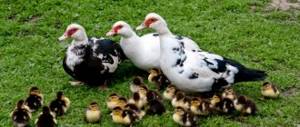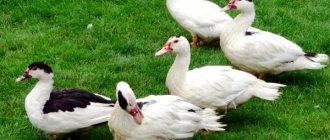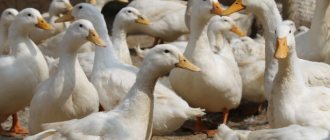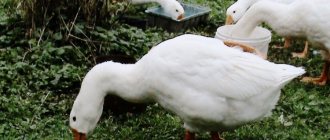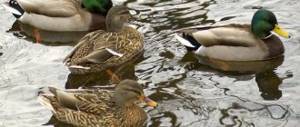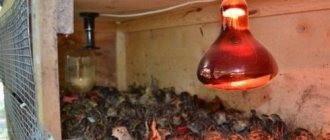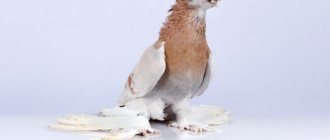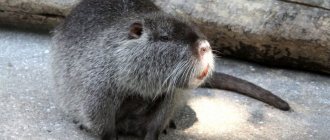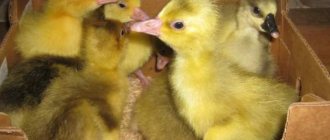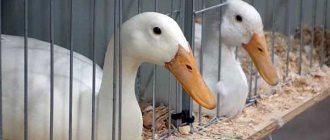History of the breed
Ducks native to the heart of China boast a very long pedigree of 300 years. Having gained gratitude in their land, the birds set out to conquer the rest of the world and were very successful in this. First, Pekingese were brought to America, and from there they began to be imported into other countries.
recommended articles:
- Domestic geese and what a farmer needs to know about them
- Caring for turkey poults: how and what to feed from the first days
Russian breeders really liked these productive ducks, and now they are kept not only on private farms, but also on large farms. Fast growth and ease of care are the main qualities for which Peking birds are loved.
Character and lifestyle
In China, these birds are usually given to newlyweds in love as a symbol of love and fidelity. Mandarin ducks, like swans, if they choose a mate, it is for life. If something happens to one of the partners, the second one never looks for someone else.
This divinely beautiful creature is often used in the practice of Feng Shui. The Chinese believe that a figurine of this amazing bird placed in a certain place can bring good luck, peace and prosperity to the house.
This is the only specimen of ducks that do not interbreed with their other brothers due to the smaller number of chromosomes. There are some other features of these ducks from other species. Mandarin ducks do not make sounds in the form of quacks. More of a whistle or squeak comes from them.
Birds change their plumage twice a year. At this time, males differ little from females. They try to gather in large flocks and hide in the thickets. For those who want to buy a Mandarin duck, it is important to remember that these birds live in warm countries, so their living conditions must be appropriate.
Appearance
The Peking duck can always be distinguished from its fellows due to its exterior features:
- strong physique;
- wide chest;
- the back is large;
- on the large head there is a characteristically convex forehead;
- the beak has a bright orange color;
- wings with good span have excellent development;
- The neck is small and not very long.
Mostly there are ducks with thick snow-white plumage, but there are also representatives with a cream color.
Productive qualities
Beijingers are an excellent choice not only for personal use, but also for starting your own business that generates profit. Breeding ducks is considered a fast-paying activity.
An adult drake has a live weight of about 4 kg, and in some cases a higher weight gain can be achieved. Ducks weigh a little less - about 3 kg.
The young are distinguished by their rapid maturity and, at the age of 60 days, gain a maximum weight of 2.9 kg in drakes. Such good productivity indicators are obtained if the diet consists of high quality feed.
Despite the fact that the breed is considered a meat breed, they are also kept for producing egg products. During one season, more than 110 eggs can be collected from a duck, the average weight of one egg is about 90 g.
How to keep Peking ducks?
A characteristic feature of this breed is a very high rate of weight gain, however, there is one peculiarity. It is profitable to keep birds until the first feather change, which is why young animals are prepared for slaughter from 60 to 90 days of life.
With the onset of the molting season, productivity indicators drop noticeably, which means that all the costs of food are simply not justified. Another factor in early slaughter is the quality of meat products; it is the young animals that have a very delicate taste. After the change of feathers occurs, the birds' internal organs begin to grow rapidly, and a new feather cover is formed. At this time, ducks are more difficult to pluck after slaughter, and many farmers note a deterioration in the taste of the resulting meat.
When breeding Pekingese, you should pay close attention to one breed feature. These birds have accelerated metabolic processes and a small intestinal size. The last factor determines the very rapid digestibility of feed, which takes approximately 4 hours. Because of this feature, feeders should always be filled with food.
A special room will have to be allocated for keeping Pekin ducks, especially in winter. An outbuilding is quite suitable; if there are holes, they need to be repaired, as well as possible cracks. It is recommended to make the floors concrete. This material has a number of advantages over short-lived wood. Ducks consume quite a large amount of water, which spills on the floor, and accordingly, sooner or later the boards will begin to rot. A layer of straw or sawdust must be used on top of the concrete.
Room temperature and light availability play an important role. With the onset of cold weather, the thermometer should show at least +10 degrees, and in hot weather no more than +25 °C. Deviation from these indicators affects the productivity of Peking ducks.
In winter, when natural light is reduced, lamps are turned on so that there is at least 13 hours of daylight.
Keeping ducks in summer is less troublesome; they are provided with a walking space equipped with canopies that protect the feeding area and provide shade for the birds. At the same time, the entrance to the room is not blocked, so that in case of bad weather or at nightfall the ducks can go inside.
It is imperative to install containers with water outside so that the birds can use it for their own purposes. Ideally, if the farm has a small natural pond, its presence significantly reduces feed costs. Ducks happily eat mud, which gives them an additional source of nutrition.
An example of a building for keeping ducks
Mandarin duck breeding
The return of mandarin ducks from wintering grounds most often occurs very early, when other birds do not even think about it. Usually not all the snow has melted by this time.
During the mating season, mandarin ducks show themselves to be not very calm birds. Males have frequent conflicts over females, which often end in fights between them.
Usually the strongest wins. He gets the honor of inseminating the female he likes. A mandarin duck's egg clutch usually contains about 12 eggs. Females lay them in nests that are located at a height of at least 6 m.
This height saves birds and their offspring from possible enemies. The female raises the offspring. This process lasts about a month. All this time, the caring mother does not leave the nest. The male takes care of her feeding.
Too much altitude does not interfere with the little chicks, who express a desire to swim from the first days of their existence. They actively fall out of the nest from high elevations to do this.
When they fall, more than half of them remain alive and are not injured. The only problem in this case may be a nearby predator who will not miss the chance to profit from the little mandarin ducklings.
Mother duck carefully teaches her babies to swim and get food for themselves. In the wild environment, mandarin ducks can face many dangers. Their lifespan lasts up to 10 years. At home, these birds can live up to 25 years.
Feeding young and adult birds
Ducklings can be fed in two ways, using wet or dry food.
In the first method, dry grain food is steamed with hot water until it reaches the consistency of porridge, and then chopped green grass, duckweed, and vegetables are added.
The dry type primarily includes ready-made feed. Because of their high cost, farmers prefer to make such food with their own hands; for this they take:
- oats;
- millet;
- corn;
- wheat.
Each owner chooses what to offer the ducklings, but it is important that grain and corn are mandatory components. Dry food is given at least five times a day; it is important that with this type of feeding the young animals always have fresh water available.
Newly born ducklings are fed boiled, finely chopped or grated eggs; from the third day, you can cook the millet until crumbly and add the egg. Some owners give porridge based on milk or broth from fish and meat. But such feeding is acceptable for ducklings that have reached two weeks of age.
The freshness of the feed plays an important role; stomach diseases can develop from sour mash, which will cause a lot of trouble for the farmer. Shell rock or fine gravel is given in separate containers.
The feeding diet varies depending on the season.
With the onset of cold weather, the feed becomes somewhat smaller, and they are fed twice a day - in the morning and in the evening. At the first feeding, you can offer wet mash, as well as combined silage; the second time, add a dry grain-flour mixture. In winter, it is important to give boiled vegetables, herbal meal and fish meal as a mineral supplement. It would be useful to have good quality hay, which will serve as a substitute for grass, but in small quantities.
In summer, it is good to provide birds with access to open water. They will find on their own the required amount of food from duckweed, mud and algae. If this is not possible, then a pasture will do, where the ducks will feed on the green mass. With this type of diet, grain mixtures are given twice a day - in the morning and in the evening.
Peking ducks on open water
When kept without walking, Pekingese are transferred to four feedings a day. Grain is given in the morning and evening hours; during the day, a wet mash is fed, which includes aquatic vegetation. You need to prepare wet food in such a way that the ducks eat it at one time, otherwise in extreme heat it will simply spoil. Fresh green mass is given to birds throughout the summer.
Despite their excellent appetite, Peking ducks need to change their food very carefully; birds are extremely sensitive to changes in diet. With a sharp transition from one type of diet to another, productivity noticeably decreases, the ability to lay eggs in some cases disappears, and the change of feathers does not occur at the right time.
What you need to know about breeding?
Thanks to genetic work, Pekin ducks have lost their maternal instinct, which means an incubator is needed to produce young animals. The optimal temperature should be +30 degrees, but otherwise raising ducklings is as easy as raising young birds of other birds.
Young animals are characterized by good survival rate. Some poultry farmers, after receiving ducklings artificially, place them under the hen. If this is not possible for some reason, then it is important to take care of a warm place for the babies. Hypothermia will not lead to anything good; young animals can simply get sick and die.
You can put a heating pad in the box where the ducklings sit, after wrapping it in a soft cloth, or hang an electric lamp or IKUF. This temperature regime is extremely important for young animals, especially in the first 14 days of life, then they can be kept at room temperature. But it is necessary to switch to this mode gradually.
For young animals, it is recommended to make a warm floor indoors and equip a small exit to the street. The presence of drafts and dampness will lead to the fact that ducklings will begin to develop colds, which can cause the death of the livestock. The floor is covered with bedding, which is regularly changed as needed and a new one is laid.
To improve meat production, crossing Peking ducks and musk drakes is used. The result is wonderful hybrids that produce more meat at the same growth rate. But they lose the ability to reproduce.
Representative of the musky breed
What are the disadvantages of the breed?
We recommend reading our other articles
- Bagira currant variety
- Apricot variety Black Prince
- Shaver Brown chicken breed
- How to grow eggplants in open ground
Experienced breeders who are accustomed to dealing with this breed may not notice its shortcomings at all. However, inexperienced, young breeders need to know that the Peking duck does not tolerate dampness and drafts in the poultry house at all, and females are bad mothers. They do not like to incubate eggs, and they do not particularly care about their offspring.
Important!
The Pekingese breed is very noisy; breeders note that it can make noise even without a seemingly significant reason. He reacts very sharply to any stressful situation. Weight may decrease, females stop laying eggs, and if they do, they are unfertilized.
